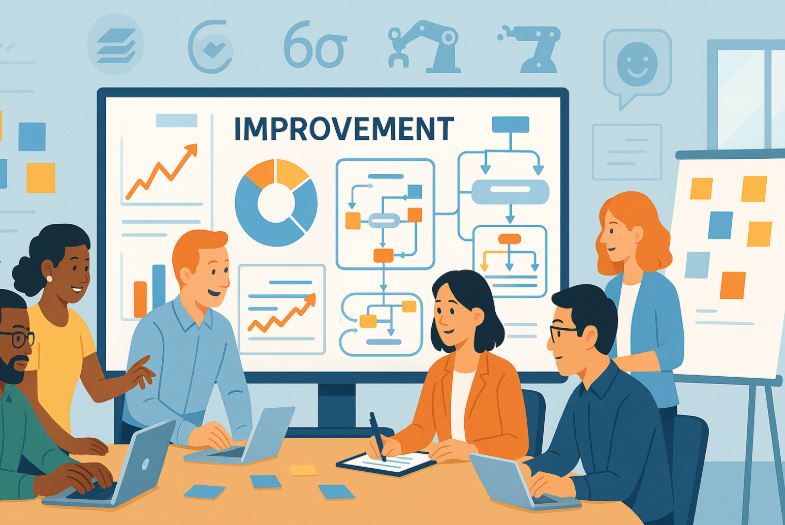According to research by McKinsey & Company, businesses that prioritise structured improvement initiatives can outperform their competitors by up to 30% in productivity.
Despite this, many organisations continue to rely on outdated processes and practices that may no longer serve them effectively. This raises an important question: Are your current business practices helping your organisation grow, or are they holding it back?
Whether you’re managing a startup or scaling a mature enterprise, embracing business improvement techniques is essential, not just for operational efficiency, but for long-term sustainability.
In this article, we explore the top 13 business improvement techniques, offering practical insights into how each method can drive measurable gains across performance, quality, customer satisfaction, and profitability.
From Lean thinking and process optimisation to stakeholder engagement and technological integration, these approaches provide a roadmap for any business looking to improve, innovate, and thrive in a dynamic commercial environment.
What Are Business Improvement Techniques and Why Do They Matter?
Even business processes that once seemed efficient can quickly become outdated as a company evolves. Growth brings new challenges, changes in market expectations, and increased operational complexity. This is where business improvement techniques (BITs) become crucial.
BITs encompass a range of structured methodologies aimed at enhancing efficiency, reducing waste, improving quality, and driving sustainable growth.
According to McKinsey, companies that invest in continuous improvement outperform their competitors by as much as 30% in productivity.
The role of business improvement is not simply to correct what’s broken. It’s about cultivating a proactive, agile, and innovation-driven mindset across the organisation.
These techniques help align day-to-day operations with long-term strategic goals, thereby creating a resilient and competitive business model.
How Can Businesses Identify Areas That Need Improvement?
Before implementing any improvement, it’s vital to gain clarity on where the current system falls short. The process typically begins with a thorough evaluation of existing workflows, performance data, and customer feedback. This helps to uncover inefficiencies, gaps in service delivery, or internal bottlenecks.
Establishing a Continuous Improvement Team that includes representatives from key departments can offer a panoramic view of how the business functions.
This team serves as the driving force behind process evaluation and can provide nuanced feedback on department-specific challenges. Their insights allow for a more informed and cohesive approach to implementing changes that actually address the root causes of inefficiency.
Which Techniques Are Most Effective for Small and Medium Enterprises (SMEs)?
For SMEs, resources such as time, funding, and manpower are often limited. Therefore, improvement strategies must be both impactful and feasible. Methods such as Lean Thinking, employee training, cross-functional collaboration, and the adoption of low-cost digital tools have proven to be particularly effective in the SME space.
What makes these techniques successful in smaller organisations is their scalability and flexibility. Unlike large-scale corporate change programmes, these approaches are designed to evolve with the business, making them sustainable over the long term.
Top 13 Business Improvement Techniques
1. Establish a Continuous Improvement Team

A dedicated continuous improvement team is the backbone of any business improvement initiative. This cross-functional group should include representatives from various departments such as operations, HR, finance, customer service, and marketing.
The idea is to ensure that improvement efforts are not siloed but instead benefit from a diversity of insights and experiences.
This team’s role is not only to identify inefficiencies and suggest improvements but also to monitor the implementation and impact of those changes over time. By continuously reviewing processes and outcomes, they help create a culture of ongoing innovation and adaptability within the organisation.
For example, if customer service experiences a spike in unresolved tickets, the team can trace the issue back to outdated communication protocols and suggest an integrated support system that reduces resolution times.
2. Evaluate Current Operations Thoroughly

You can’t improve what you haven’t measured. A deep dive into your existing processes, structures, and resource allocation provides the foundation for any effective change. Start with process mapping, visually documenting how tasks are currently completed from start to finish.
Meet with staff from each department individually and in groups to identify pain points, inefficiencies, and recurring obstacles.
You may find, for instance, that while your sales team excels at lead generation, delays in quote processing cause a high drop-off rate. Understanding these granular details allows for targeted improvement strategies rather than sweeping, ineffective changes.
Evaluation should also include performance data, such as KPIs, customer feedback, and financial reports, to form a data-driven view of what’s working and what’s not.
3. Develop a Structured Action Plan

Having an idea for improvement isn’t enough, you need a roadmap. An action plan should clearly state:
- The specific issue being addressed
- What needs to change
- The people responsible
- Tools and resources needed
- A timeline for implementation
- Metrics for measuring success
Structured planning ensures consistency and prevents initiatives from stalling due to lack of direction or clarity. It’s particularly important when managing multiple improvements across departments or teams.
Moreover, planning enables you to assess the feasibility of each proposed change, helping you prioritise initiatives that deliver the highest return on investment.
Skanska UK, for example, revolutionised their operations by identifying core areas (functional, project control, and sector-specific processes), then applying a consistent framework to streamline them through a centralised management platform.
4. Simplify and Communicate Improvement Plans Clearly

Even the most well-thought-out improvement plan is ineffective if stakeholders and employees don’t understand it. Avoid jargon, keep language simple, and ensure all staff, regardless of department or seniority, understand:
- What is changing
- Why it’s changing
- How it impacts their role
Consider using visual aids such as flowcharts, infographics, or simple checklists. For technical changes, provide glossaries or training modules to bring everyone up to speed. This clarity builds trust, reduces resistance, and accelerates adoption.
A great example is the software team in an organisation standardising bug-fix workflows. By breaking down the improvement plan into simple, clear steps, and avoiding technical overload, the wider team better understands its value and supports its execution.
5. Implement an Effective Communication Strategy

Communication is often the Achilles’ heel of business improvement. A lack of communication can cause confusion, frustration, and ultimately failure. Therefore, communication must be intentional, layered, and consistent.
This may include:
- Scheduled progress updates
- Departmental briefings
- Anonymous feedback forms
- Town hall-style meetings
- Visual branding around the workplace (e.g., posters, dashboards)
Companies like Equifax have successfully implemented multi-stranded communication strategies by branding their process improvement systems (like “HUB”) and promoting them through events, newsletters, and branded materials. This constant reinforcement ensures that improvement efforts are front of mind for everyone in the business.
6. Integrate Industry Best Practices

Best practices are proven methods that consistently deliver superior results. Whether it’s ISO-certified quality standards, Agile frameworks, or financial compliance procedures, incorporating these into your operations can significantly elevate performance.
The key is to not just copy best practices blindly but to adapt them to your organisation’s context. For example, implementing Agile in a marketing team might mean adopting weekly sprints and review meetings, whereas in manufacturing, it could focus on reducing lead time and batch sizes.
Sungard Availability Services achieved consistency and clarity across its global teams through a centralised process library (‘ASK PAT’), helping standardise quality, reduce errors, and earn international certifications like ISO20000.
7. Engage Stakeholders from the Start

The support of key stakeholders, senior leaders, department heads, investors, or clients, is crucial. Their endorsement helps secure resources, build internal credibility, and motivate others to participate.
Start by identifying all relevant stakeholders and their influence levels. Use stakeholder mapping tools and engagement plans to keep them informed and involved. Stakeholders should feel that their insights are valued and that they have a role in shaping the future of the business.
National Oilwell Varco, for instance, formed an ‘Operational Excellence Group’ with stakeholder input to ensure their improvement efforts addressed both technical and cultural issues, resulting in more comprehensive and successful changes.
8. Allocate Resources Strategically

Resources, both human and material, play a pivotal role in any improvement initiative. Understanding what your teams need to succeed can dramatically improve execution and outcomes.
Resources might include:
- Software systems
- Specialist personnel
- Equipment upgrades
- Training and development
- Budget increases
Gather insights from team leaders and employees on what they lack to perform optimally. This bottom-up feedback ensures that resource allocation is aligned with real needs, not assumptions.
9. Hold Regular Performance Review Meetings

Improvement is iterative. Regular review meetings ensure that initiatives remain on track and problems are addressed early. These reviews can be held weekly, monthly, or quarterly depending on the size and complexity of the change.
Each session should cover:
- Progress updates
- Key metrics
- Feedback from frontline teams
- Any blockers or issues
Make sure that meeting outcomes are documented and distributed so that accountability is maintained and momentum is not lost. These check-ins also reinforce the message that improvement is an ongoing commitment, not a one-time project.
10. Encourage Cross-Departmental Collaboration

Departments often operate in silos, which can hinder information flow and create inefficiencies. Cross-departmental collaboration fosters shared understanding, sparks innovation, and helps uncover interdependencies that may otherwise be missed.
Create opportunities for teams to work together, such as joint workshops, cross-functional projects, or job-swapping programmes.
For example, sales and marketing teams collaborating on a new campaign can ensure that messaging aligns with real customer pain points and that sales strategies match marketing efforts. Collaboration breaks down barriers and creates a more agile, unified organisation.
11. Foster Diversity and Inclusion in Improvement Initiatives

A diverse team is better equipped to solve complex problems. Inclusion ensures that all voices are heard and considered, leading to more robust and innovative solutions.
When planning improvements, include team members from different backgrounds, roles, and experiences. This ensures a holistic view of business challenges and prevents blind spots.
Organisations that embrace diversity often see better employee morale, improved customer understanding, and enhanced brand reputation, factors that all contribute to long-term success.
12. Apply Lean Management Principles

Lean is about doing more with less by eliminating waste and focusing on customer value. It relies on several core tools:
- Value Stream Mapping: Visualising processes to identify inefficiencies
- 5S: Creating an organised, safe, and efficient workspace
- Just-In-Time: Reducing inventory and speeding up delivery
Originally developed in manufacturing, Lean has been successfully adapted to service industries, healthcare, and even education. Its adaptability makes it a vital part of any business improvement toolkit.
13. Leverage Technology and Automation

Technology is an enabler, not a substitute, for good processes. Tools such as CRM systems, project management software, automation platforms, and data analytics tools can significantly enhance improvement efforts.
Automating repetitive tasks reduces human error, frees up time for high-value activities, and ensures consistent execution. Data analytics, on the other hand, helps measure the effectiveness of improvements and guide future decisions.
Businesses that integrate the right tech tools into their improvement strategies gain a competitive edge through speed, accuracy, and agility.
Business Improvement Techniques Used by Leading Companies
From multinational corporations to SMEs, businesses that lead in operational excellence often follow a consistent set of steps. These include forming an Operational Excellence Group, crafting a clear Implementation Plan, and applying a practical Business Management System that is both usable and widely accessible.
These organisations also focus on stakeholder engagement, apply easy-to-understand methodologies, and consistently capture and analyse the current state of affairs through process mapping.
Companies like Skanska UK, Homeserve, and Lockheed Martin UK have documented measurable results from adopting these techniques, ranging from award-winning quality certifications to enhanced service consistency and employee engagement.
Comparison Table of Key Techniques
| Technique | Focus Area | Primary Benefit |
| Lean Management | Waste Elimination | Operational Efficiency |
| Continuous Improvement | Incremental Adjustments | Sustained Long-Term Growth |
| Strategic Planning | Organisational Direction | Unified Business Vision |
| Workflow Optimisation | Task Execution | Streamlined Operations |
| Employee Engagement | Workforce Productivity | Better Retention and Innovation |
Conclusion
Business improvement is not simply about upgrading tools or automating tasks, it’s a strategic commitment to excellence at every level of the organisation.
From evaluating current operations to fostering inclusivity and applying Lean methodologies, the techniques outlined above offer a comprehensive roadmap for meaningful and measurable transformation.
Implementing even a few of these strategies can create ripple effects across productivity, profitability, customer satisfaction, and employee morale. Businesses that adopt a proactive approach to improvement position themselves not just for short-term wins but for long-lasting, competitive advantage.
FAQs
What are business improvement techniques used for?
They’re used to systematically improve efficiency, productivity, quality, and profitability across different business functions.
Are these techniques only for large companies?
No. SMEs can benefit significantly by adopting scalable, cost-effective strategies such as Lean Thinking, workflow optimisation, and stakeholder engagement.
What makes a continuous improvement team effective?
Cross-departmental representation, regular meetings, and a clear mandate to analyse and recommend process changes are key to effectiveness.
Why is stakeholder engagement important in business improvement?
Stakeholders can provide critical support, resources, and insight that help shape and reinforce successful implementation.
What role does technology play in these techniques?
Technology aids in process automation, data analysis, and communication, drastically increasing the speed and effectiveness of improvements.
Is there a best method for improving business operations?
There’s no one-size-fits-all method. The best approach is a tailored mix of Lean, Six Sigma, and strategic planning, aligned with your specific business goals.
How do performance metrics support improvement initiatives?
Metrics like KPIs help track progress, identify weaknesses, and demonstrate the impact of change.








